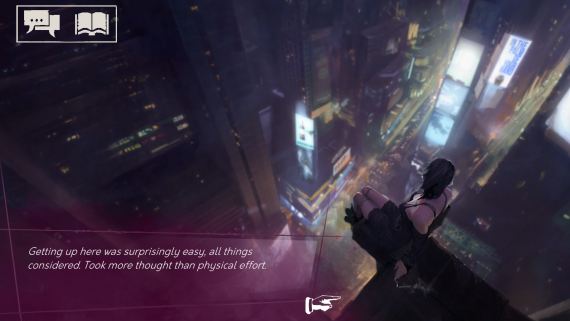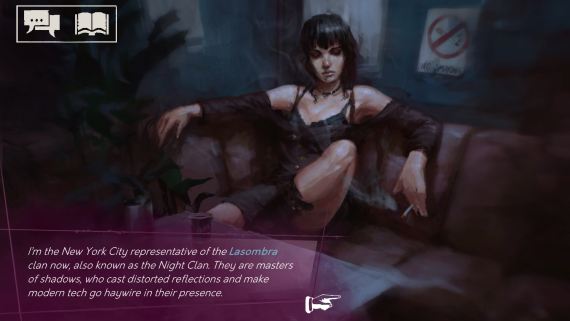Anyone who has had contact with Coteries will quickly find out about the new title. Both the core of the gameplay and most of the interface remain the same. We read dialogues and descriptions, admire the refined two-dimensional graphics in a comic (and appropriately dark) style, once in a while we choose one of several dialogue options or an activity available on the city map. And basically that’s it, because this installment of the series has even gone through some simplifications, resigning from, among others, from the mechanics of tracking the vampire hunger of our heroine.
More personal, more closed
Well, “heroines”, because this time she is only one, and thus we cannot influence her gender, appearance or even the clan to which she belongs. Our avatar, for better and for worse, is Julia Sowinski, an American of Polish descent, unexpectedly incorporated into the Lasombra ranks. Such a solution has both advantages and disadvantages, which are probably not difficult to guess.

On the one hand, we have fewer variables here, so we can lean into the character much closer and learn more about her past, worldview, personality, and so on. On the other hand, however, it is less “ours”, which may make it difficult to identify with it, as well as limit the roleplay potential, and with it also replayability. At least that’s what it looks like in theory – and how with practice?
Is it really a novelty?
In my opinion, a little worse than it should be. The introduction of the heroine and the presentation of her life before the transformation are not much more extensive than in the case of the three potential protagonists of the Coteries . Moreover, after starting her new “non-life”, Julia is going through an identity crisis through which she tries to define who she really is and who she should be. Narratively, it makes sense, but for the player it comes down to one thing – a blank card waiting to be written down. The system monitors it quite directly, pinning us specific “patches” based on decisions made at several key moments. These, in turn, later slightly change Julia’s behavior during non-interactive dialogues, and their final arrangement will also determine the ending we will see.
I have already mentioned “going back to the old rubbish” – is it just about visiting the same city again? Of course not. New York is still inhabited by both factions we already know – the Camarilla and the Anarchists – and they include bloodsuckers friends. Some people will only flash somewhere in the background as part of a small cameo , with others we will spend more time getting to know them from a slightly different side (I especially appreciate the development of Sheriff Qadir). The companions of our former protagonist – Agathon, Hope, Tamika and D’Angelo will also be important for the main plot. Thanks to this, we will get a rough idea of what happened to them later, because the action of Shadows of New York takes place about a year after the events of Coteries. Similarly, the elite of the vampire world, with which we will have to struggle in the political game, have not changed.

An unequivocally positive novelty is the opportunity to guide a member of the Lasombra clan, who has not been a playable option in any of the older titles set in the World of Darkness so far . Simply put, it seems to be a sort of the Ventrue clan’s counterpart to the Sabbat to which it historically belonged, with a hint of the mysticism characteristic of Tremere. Thanks to her bloodline, Julia is able to blend with shadows and see ghosts clearly trying to communicate with her. I regret that the topic of the specificity of Lasombra vampires was not developed further here, because it was one of the more interesting aspects of the new title for me. I would love to see this clan in action in some larger production, e.g. in the upcoming Bloodlines 2 , but the chances of that are rather slim – which is a pity!
A significant step … back
Overall, Shadows of New York is a decent game with a great atmosphere, a tolerable story and quite an interesting protagonist. The only problem is that it probably doesn’t do anything better than the Coteries , but in some respects it fares worse. Yes, the previous game in many respects only branded its own non-linearity and the importance of player choices, but – nonetheless – allowed for limited roleplay and encouraged at least double playthrough to try out all optional activities. In this expansion, the creators consciously gave up this approach, but offered little in return – apart from a fresh story, we are dealing with a poorer clone.

In addition, the story itself was also a disappointment for me – although it was supposed to be more moving than its predecessor, it involved me less. Julia, although written very decently, is not able to handle the plot on her own, and apart from her, only a handful of side characters return to the screen often enough for us to take on any stronger attitude towards them, be it positive or negative. It is similar with conversations – in Shadows we have much more passive reading, uninterrupted even with completely trivial dialogue options, which would give us some semblance of an influence on how this discussion will turn out.
While the story is certainly not boring and the gameplay is short, I was expecting something more. The final solution to the investigation plot, which is the central point of the lion’s part of the plot, is a big ball and chain here. It turned out to be a very big profession for me, which called into question the meaning of many activities that I took throughout the game. The final scene itself was satisfying and successful, but, as the saying goes, the distaste remains. Just like the lack of willingness to pass the title again – and in the case of Coteries , I started a new game right after watching the credits.
We would like to thank the Draw Distance studio for making a copy of the game available for review .

